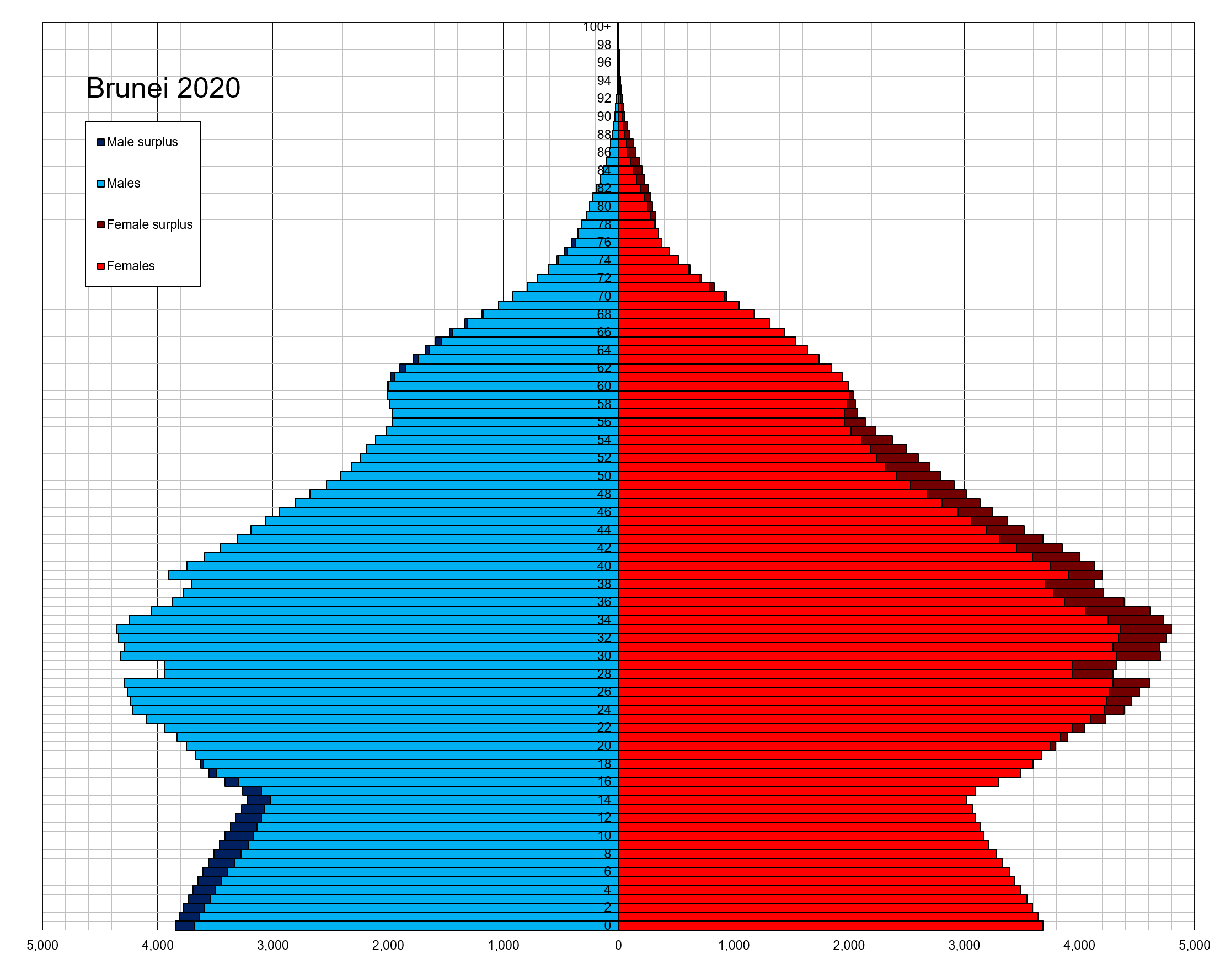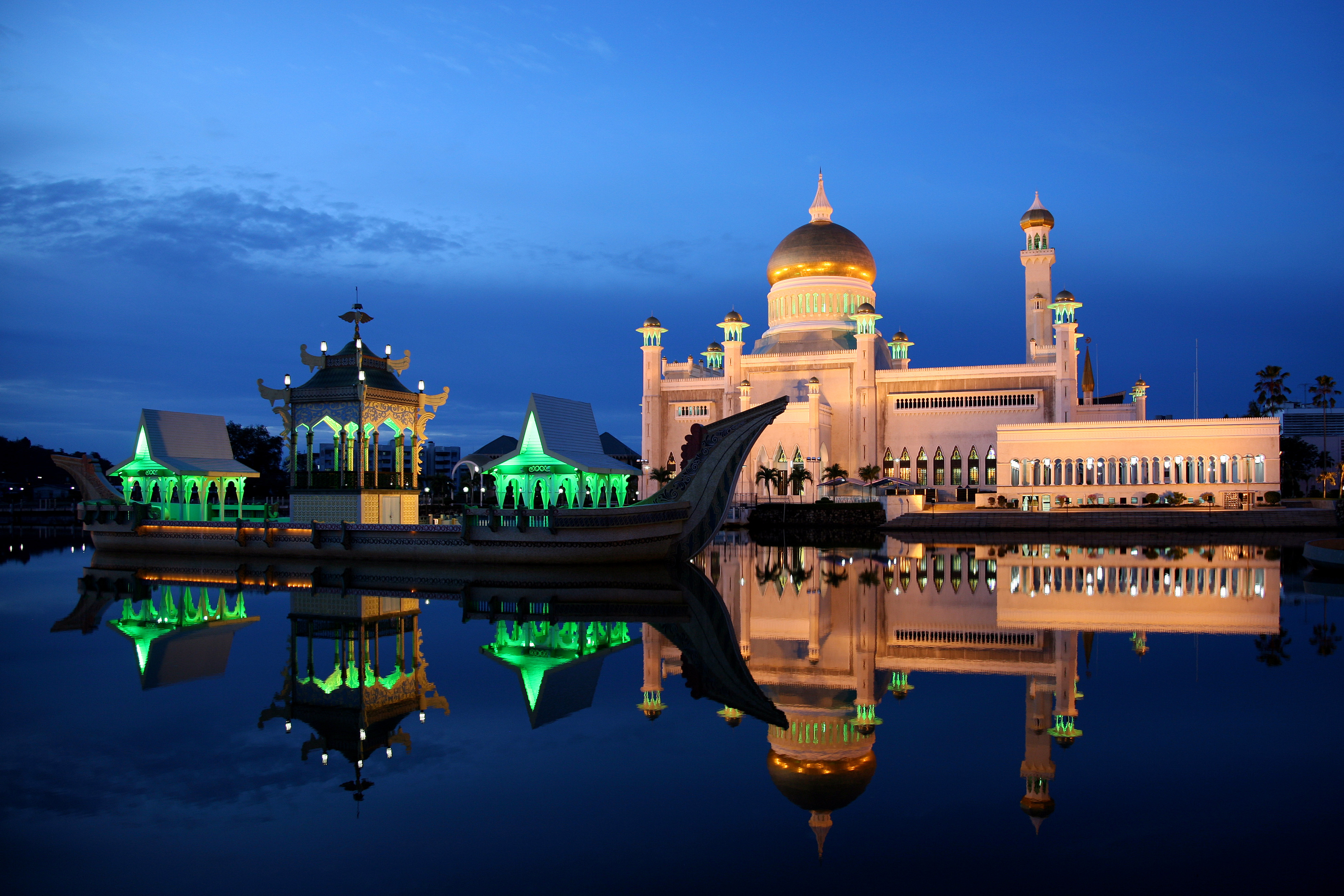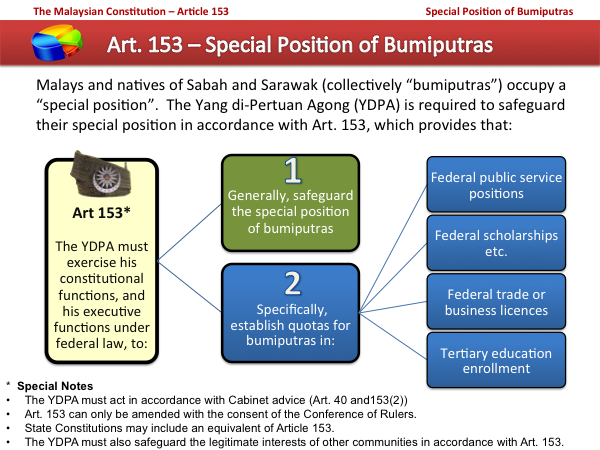|
Bumiputera (Brunei)
The indigenous peoples of Brunei are Bruneian people who belong to the ethnic groups considered indigenous to the country. It is more commonly attributed to indigenous people of the Malay race belonging to the seven ethnic groups, namely: Brunei, Tutong, Belait, Dusun, Murut, Kedayan and Bisaya. The local term refers to citizens of indigenous descent, in particular the aforementioned seven ethnic groups. The term has also been sometimes used to refer to the indigenous peoples. Definition According to the Brunei Nationality Act, the indigenous people of Brunei are mainly classified into Malays and non-Malays. Indigenous Malays comprise the following ethnic groups: * Brunei * Tutong * Belait * Dusun * Murut * Kedayan * Bisaya Meanwhile the indigenous people other than the Malays are defined in the First Schedule of the Act to comprise the following ethnic groups: * Bukitans * Dayaks (sea) * Dayaks (land) * Kelabits * Kayans * Kenyahs (including Sabups and Sipengs) ... [...More Info...] [...Related Items...] OR: [Wikipedia] [Google] [Baidu] |
Bruneian People
The demographic features of Brunei include population density, ethnicity, education level, health of the populace, economic status, religious affiliations and other aspects of the population. Like neighbouring countries, Brunei is a Malay-dominated country. Many cultural and linguistic differences make Brunei Malays distinct from the larger Malay populations in nearby Malaysia and Indonesia, even though they are ethnically related and share the Muslim religion. Brunei has a hereditary nobility with the title Pengiran these are, more often than not, related to the Sultan by blood. The Sultan can award to commoners the title Pehin, the equivalent of a life peerage awarded in the United Kingdom. The Sultan also can award his subjects the Dato, the equivalent of a knighthood in the United Kingdom, and Datin, the equivalent of a damehood. Bruneians adhere to the practice of using complete full names with all titles, including the title Haji (for men) or Hajjah (for women) for those w ... [...More Info...] [...Related Items...] OR: [Wikipedia] [Google] [Baidu] |
Public Housing Estates In Brunei
This is a list of public housing estates in Brunei. The list consists of housing estates under the current government housing programmes of the National Housing Scheme (), including the Landless Indigenous Citizens' Housing Scheme (), as well as the former National Resettlement Scheme (). The housing estates may be part of village subdivisions, the third-level subdivisions of Brunei, but many of them have large enough population and hence are designated as separate villages; a few may even very large population that they are divided into few village subdivisions. {, class="wikitable sortable" , +Public housing estates in Brunei !Estate !Area !Village subdivision !District , - , rowspan="7" , of Berakas , rowspan="7" , Berakas , Anggerek Desa , rowspan="38" , Brunei-Muara , - , Burong Pingai Berakas , - , Pancha Delima , - , Pengiran Siraja Muda Delima Satu , - , Jaya Bakti , - , Jaya Setia , - , Orang Kaya Besar Imas , - , of Bunut , Bunut , Bunut Perpindahan , - , Lugu ... [...More Info...] [...Related Items...] OR: [Wikipedia] [Google] [Baidu] |
Greater Indonesia
Greater Indonesia (in id, Indonesia Raya) was a political concept that sought to bring the so-called Malay race together by uniting the territories of Dutch East Indies (and Portuguese Timor) with the British Malaya and British Borneo. It was espoused by students and graduates of Sultan Idris Training College for Malay Teachers in the late 1920s, and individuals from Sumatra and Java including Mohammad Natsir and Sukarno on September 28, 1950. ''Indonesia Raya'' was adapted as the name of what later became the Indonesian national anthem in 1924. While the definition of Greater Indonesia () is consistent, the definition of Greater Malay () and related concept of Malay world and realm ( and ) are varied from the synonym of Greater Indonesia to Peninsular-focused dominance. Ancient and Colonial Maritime South East Asia The ancient concept of ''Nusantara (archipelago)'' advocates an historical awareness that the territory of British Malaya, British Borneo and the Dutch East I ... [...More Info...] [...Related Items...] OR: [Wikipedia] [Google] [Baidu] |
Nusantara (archipelago)
''Nusantara'' is the Indonesian name of Maritime Southeast Asia (or parts of it). It is an Old Javanese term that literally means "outer islands". In Indonesia, it is generally taken to mean the Indonesian Archipelago. Outside of Indonesia, the term has been adopted to refer the Malay Archipelago. The word Nusantara is taken from an oath by Gajah Mada in 1336, as written in the Old Javanese ''Pararaton'' and ''Nagarakretagama''. Gajah Mada was a powerful military leader and prime minister of Majapahit credited with bringing the empire to its peak of glory. Gajah Mada delivered an oath called ''Palapa oath'', in which he vowed not to eat any food containing spices until he had conquered all of Nusantara under the glory of Majapahit. The concept of Nusantara as a unified region was not invented by Gajah Mada in 1336. The term Nusantara was first used by Kertanegara of Singhasari in Mula Malurung inscription dated 1255. Furthermore, in 1275, the term ''Cakravala Mandala Dvipanta ... [...More Info...] [...Related Items...] OR: [Wikipedia] [Google] [Baidu] |
Maphilindo
Maphilindo (for Malaya, the Philippines, and Indonesia), is a proposed, nonpolitical confederation of the three Southeast Asian countries in the Malay Archipelago. Background The original plan for a united state based on the concept of the Malay race was attempted by Wenceslao Vinzons during the Philippines' Commonwealth era. Vinzons had envisioned a united Malay race, which he termed "Malaya Irredenta" (later another name for the union). In his 1959 book ''Someday, Malaysia'', Major Abdul Latif Martelino (later operations officer in the infamous Jabidah massacre) also cited the vision of President Manuel L. Quezon for an integrated, pan-Malayan nationhood in the region. Quezon envisioned creating a better state which was united. Having a united race at the time would pave way for the development of the Malay. The united state would however, be achieved by the contribution of the people living in the region. Quezon was determined to make his intentions known to the peopl ... [...More Info...] [...Related Items...] OR: [Wikipedia] [Google] [Baidu] |
East Indies
The East Indies (or simply the Indies), is a term used in historical narratives of the Age of Discovery. The Indies refers to various lands in the East or the Eastern hemisphere, particularly the islands and mainlands found in and around the Indian Ocean by Portuguese explorers, soon after the Cape route was discovered. Nowadays, this term is broadly used to refer to the Malay Archipelago, which today comprises the Philippine Archipelago, Indonesian Archipelago, Malaysian Borneo, and New Guinea. Historically, the term was used in the Age of Discovery to refer to the coasts of the landmasses comprising the Indian subcontinent and the Indochinese Peninsula along with the Malay Archipelago. Overview During the era of European colonization, territories of the Spanish Empire in Asia were known as the Spanish East Indies for 333 years before the American conquest. Dutch occupied colonies in the area were known for about 300 years as the Dutch East Indies till Indonesian indepen ... [...More Info...] [...Related Items...] OR: [Wikipedia] [Google] [Baidu] |
Malay Archipelago
The Malay Archipelago (Indonesian/Malay: , tgl, Kapuluang Malay) is the archipelago between mainland Indochina and Australia. It has also been called the " Malay world," "Nusantara", "East Indies", Indo-Australian Archipelago, Spices Archipelago and other names over time. The name was taken from the 19th-century European concept of a Malay race, later based on the distribution of Austronesian languages. Situated between the Indian and Pacific Oceans, the archipelago of over 25,000 islands and islets is the largest archipelago by area and fourth by number of islands in the world. It includes Brunei, East Timor, Indonesia, Malaysia (East Malaysia), Papua New Guinea, the Philippines and Singapore.''Encyclopædia Britannica''. 2006. Chicago: Encyclopædia Britannica, Inc. The term is largely synonymous with Maritime Southeast Asia. [...More Info...] [...Related Items...] OR: [Wikipedia] [Google] [Baidu] |
Malay World
The Malay world or Malay realm (Indonesian/Malay: or ; Jawi: ), is a concept or an expression that has been used by different authors and groups over time to denote several different notions, derived from varied interpretations of Malayness, either as a racial category, as a linguistic group or as a cultural group. The use of the term 'Malay' in much of the conceptualisation is largely based on the prevalent Malay cultural influence, manifested in particular through the spread of the Malay language in Southeast Asia as observed by different colonial powers during the Age of Discovery and spread of Islam. The term remains highly controversial outside of Malay-speaking areas and as such is considered politically charged and irredentist rather than purely cultural. The concept in its broadest territorial stretch may apply to a region synonymous with Austronesia, homeland to the Austronesian peoples, that extends from Easter Island in the east to Madagascar in the west. Such ... [...More Info...] [...Related Items...] OR: [Wikipedia] [Google] [Baidu] |
Pribumi
Native Indonesians, also known as ''Pribumi'' (), are Indonesians whose ancestral roots lie mainly in the archipelago, distinguished from Indonesians of known (partial) foreign descent, like Chinese Indonesians (Tionghoa), Arab Indonesians, Indian Indonesians and Indo-Europeans (Eurasians). Etymology and historical context The term was popularized after Indonesian independence as a respectful replacement for the Dutch colonial term (normally translated as "native" and seen as derogatory). It derives from Sanskrit terms ''pri'' (before) and ''bhumi'' (earth). Before independence the term (Malay: son of the soil) was more commonly used as an equivalent term to ''pribumi''. Following independence, the term was normally used to distinguish indigenous Indonesians from citizens of foreign descent (especially Chinese Indonesians). Common usage distinguished between ''pribumi'' and ''non-pribumi''. Although the term is sometimes translated as "indigenous", it has a broader meaning ... [...More Info...] [...Related Items...] OR: [Wikipedia] [Google] [Baidu] |
Malayness
Malayness ( ms, Kemelayuan, Jawi: ) is the state of being Malay or of embodying Malay characteristics. This may include that which binds and distinguishes the Malay people and forms the basis of their unity and identity. People who call themselves Malay are found in many countries in Southeast Asia, united by a notional shared identity but divided by political boundaries, divergent histories, variant dialects and peculiarities of local experience. While the term 'Malay' is widely used and readily understood in the region, it remains open to varying interpretations due to its varied and fluid characteristics. 'Malay' as an identity, or nationality, is considered one of the most challenging and perplexing concepts in the multi-ethnic world of Southeast Asia. Much of the ethos of Malay identity are thought to originate from the ascendancy of Melaka Sultanate in the 15th century. After the fall of Melaka in 1511, the notion of Malayness developed in two ways: to claim lines of k ... [...More Info...] [...Related Items...] OR: [Wikipedia] [Google] [Baidu] |
Bumiputera (Malaysia)
''Bumiputera'' or ''Bumiputra'' ( Jawi: ) is a term used in Malaysia to describe Malays, the Orang Asli of Peninsular Malaysia, and various indigenous peoples of East Malaysia (see official definition below). The term is sometimes controversial, and has similar usage in the Malay world, used similarly in Indonesia and Brunei. The term is derived from the Sanskrit which was later absorbed into the classical Malay word ( sa, भूमिपुत्र, bhū́miputra), which can be translated literally as "son of the land" or "son of the soil". In Indonesia, this term is known as "Pribumi". In the 1970s, the Malaysian government implemented policies designed to favour bumiputras (including affirmative action in public education and in the public sector) to elevate the socioeconomic status of the economically disadvantaged bumiputera community and to defuse interethnic tensions following the 13 May Incident in 1969 by placating the Malay majority through granting them a pri ... [...More Info...] [...Related Items...] OR: [Wikipedia] [Google] [Baidu] |
Minority Rights Group International
Minority Rights Group International (MRG) is an international human rights organisation founded with the objective of working to secure rights for ethnic, national, religious, linguistic minorities and indigenous peoples around the world. Their headquarters are in London, with offices in Budapest and Kampala. MRG has an international governing Council that meets twice a year. MRG has consultative status with the United Nations Economic and Social Council (ECOSOC) and observer status with the African Commission on Human and Peoples' Rights. The organisation was set up in 1969 by a group of activists and academics in order "to protect the rights of minorities to co-exist with majorities, by objective study and consistent international public exposure of violations of fundamental rights as defined by the UN Charter".Founding statement of aims, Minority Rights Group Its first director was David Astor, editor and proprietor of ''The Observer'' newspaper at the time. See also *Geno ... [...More Info...] [...Related Items...] OR: [Wikipedia] [Google] [Baidu] |


.jpg)



